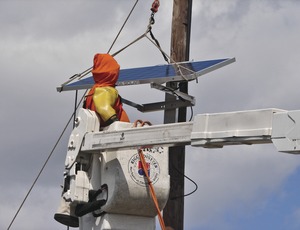For the first time, New Jersey nabbed the top spot this year in terms of installing photovoltaic (PV) capacity, surpassing California, the country's longtime solar energy leader. Public Service Electric and Gas Co. (PSE&G), New Jersey's largest utility, has already built a hefty portion of that capacity and, by early 2013, will wrap up a four-year program to install 40 megawatts of power via telephone pole-mounted solar units. The distributed solar program, which will provide enough energy to power 6,500 homes, is the largest of its type worldwide.


"Everything we do connects straight to the distribution system," says Andrew Powers, program manager of Solar 4 All, PSE&G's program that aims to add 80 MW of solar electric generation capacity to its system by next year. The pole-mounted program will provide half of that goal with installations in more than 300 New Jersey towns that the utility serves.
The project initially aimed to put 200-watt panels on 200,000 poles, but as technology advanced, so did the power capacity of the panels. "We're now up to 245-watt panels, so we're looking at 180,000 poles to be utilized," Powers says.
Each panel is about 10 sq ft. "There's nothing special about the panel itself. You'd use the same kind of panel on a solar farm," Powers says. But it is the smart grid technology that enables the panels to work with the utility grid that is at the heart of the $275-million to $280-million project.
Developed by Petra Solar, South Plainfield, N.J., the wireless smart grid technology attaches to each panel, allowing the panel to communicate with the grid and be monitored, says Shihab Kuran, chief executive of Petra, which is also the designer and engineer of the PSE&G project.
The technology monitors energy output to the grid and can disconnect that output in the event of a problem, he says. Housed in a small "smart box," it works alongside a microinverter, energy monitor and grid voltage sensor to provide PSE&G constant feedback.
Off-grid, pole-mounted PVs have been in use for decades, used primarily by developing countries that have little, expensive, poor or no other power infrastructure. But Petra's system is the first to utilize grid-connected, pole-mounted technology, Kuran says.
Kuran, who conceived the PSE&G project, says the idea arose when he was reading statistics about the California market. "About 97% of the renewables projects in California were never built or significantly behind schedule or significantly above budget in 2007 and 2008," he says.
New Jersey was already progressive in solar power, but it could not match California's strength, largely because New Jersey is a more densely populated state with little undeveloped land, he says. "We don't have deserts here, and we needed very large deployment" for utility-scale programs, he adds. Land and labor costs in the state were also prohibitive.
But with a desire to boost his state's solar market standing, Kuran came up with the pole-mounted plan one day when the proverbial light bulb—or solar panel—lit up as he was staring out of his office window. He noticed the many utility poles within sight when it dawned on him: "We could do a utility-scale project without taking up utility-scale land."
When he first approached PSE&G, however, he was sent back to the drawing board. At that point "we only had the photovoltaic part, not the smart grid," Kuran says. Petra would have to meet a long list of criteria before anything could be attached to one of the utility's poles. This included designing a system that would stabilize and not disrupt the grid, and one that is "ruggedized" so that if a bucket truck bumped into it, "it wouldn't fall apart," Kuran says.
After months of R&D work, Petra developed the high-tech panel system—the first integration of solar and smart grid technology—and received the PSE&G contract. The technology won Petra two TechAmerica Foundation honors last year—the Clean Tech/Green Tech as well as Smart Grid & Smart Instruments awards. Greentech Media also named Kuran one of the "100 people you must know in smart grid in 2012."









Post a comment to this article
Report Abusive Comment